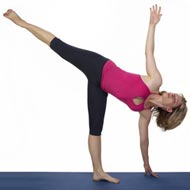- Aromatherapy (36)
- Benefits of Yoga (282)
- Home Remedies (1087)
- massage therapy (9)
- Preventive Therapy (135)
- Running (41)
- Skin Care (15)
- Stress Relief (25)
- Stretching (5)
- walking (33)
- Womens Health (14)
- Yoga Benefits for Pregnant Women (16)
- Yoga Benefits for Students (3)
- Yoga for Children (11)
- Yoga for Holistic Living (37)
- Yoga for Midlife Crisis (3)
- Yoga for Senior Citizens (2)
- Yoga for the Workplace (1)
- Yoga Health Tips (185)
- Yoga Practice during Menstruation (5)
Yoga Poses And Tips For Beginners

Yoga is the most ancient form of physical fitness, which is aimed at uniting and synchronizing the mind, body, and soul of a person. Its roots can be traced back to India, to beyond 3000 B.C., when people who were keen on meditating for long periods lasting from a few days to months used yoga to train their mind and bodies to withstand austere conditions without losing focus and getting distracted.
Today, it has transcended the Indian sub-continent and has followers all across the globe. It has many branches such as Hatha Yoga, Raja Yoga, Bhakti Yoga, Tantra Yoga, Jnana Yoga, Karma Yoga, and Kriya Yoga. The most popular amongst these is Hatha yoga, which involves performing yoga postures along with synchronizing your breath and performing various breathing exercises or pranayama. Hatha Yoga itself has about 9 certified branches. These have been developed by yoga gurus and vary in method of action. Ashtanga Yoga, Iyengar Yoga, Jivamukti Yoga, Bikram Yoga are examples of Hatha Yoga.
As a beginner, it is always advisable that you enroll yourself in beginner’s yoga classes. However, before doing so, it is important that you acquire basic knowledge about the different yoga methodologies. Iyengar and Ashtanga Yoga are best suited as yoga for beginners and have several centers that teach them. Iyengar yoga is good for those whose flexibility levels are low and lack physical stability. Iyengar yoga utilizes props that help in maintaining postures and provide support. Ashtanga yoga does not rely on props but rather on one’s own self. However, even this form of yoga can be practiced at a beginner’s level. Kundalini Yoga for beginners is ideal for those who wish to relieve stress and anxiety.
One must understand that yoga is not like modern day aerobics and weight training sessions and it might not appeal to many at first. However, its results are long lasting if practiced with consistency and focus over a period of time.
The best time to practice it is in the morning on an empty stomach and a clear mind. It can however be practiced during anytime of the day provided you maintain a gap of at least 3 hours between your meals and the yoga session. You will require a mat and loose clothing which allow for ample movement.
Yoga does not only help you maintain a lean body, but helps you cure many heath problems, organize your thought patterns, energy flow and eliminates negativity from your life. For those who wish to learn at home, books and yoga for beginners DVDs are available everywhere. The information available is so vast that you can easily get confused and can be led astray. It is best to select the ones that are officially certified and released by the main yoga centers. If you do not have ample time to follow complete yoga sessions, you could opt for power yoga for beginners.
- RSS Feeds -
- All posts
- All comments
- Running Tips For Beginners Running and jogging are found to have innumerable health benefits. Running is...
- Yoga Benefits for Beginners There are several joints in the body that require movement and lubrication. T...
- Are you ready to take it to the next level? A regular yoga practice can be a powerful tool in bringing health and wellbeing ...
- Running For Beginners Running is an easy and simple exercise that can be done by anyone. It helps i...